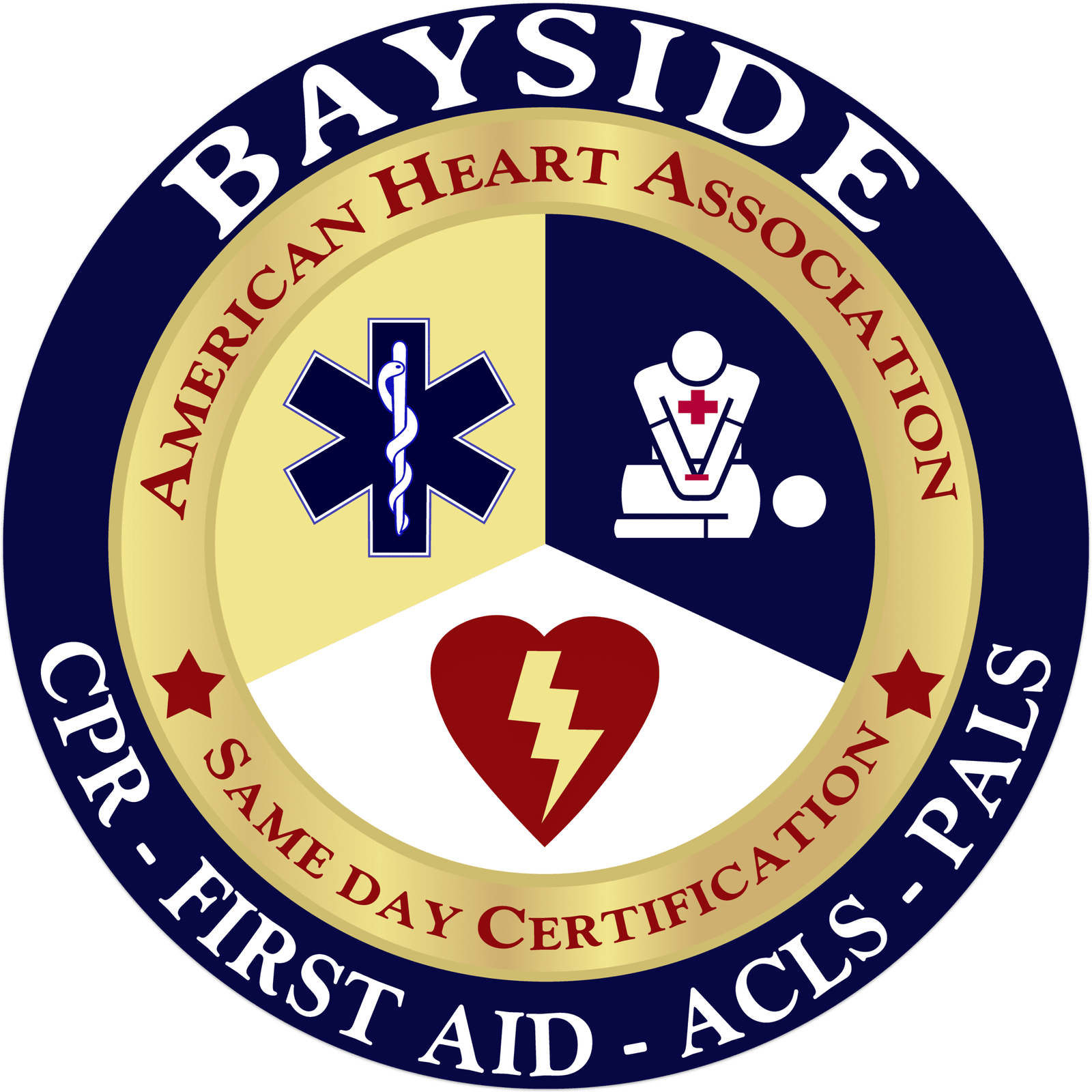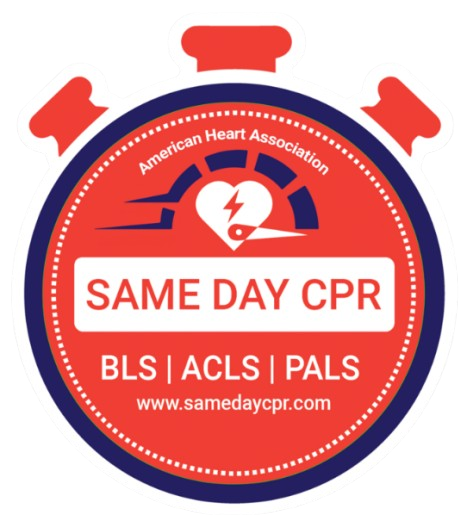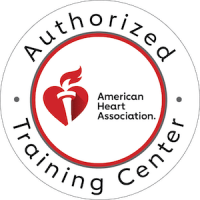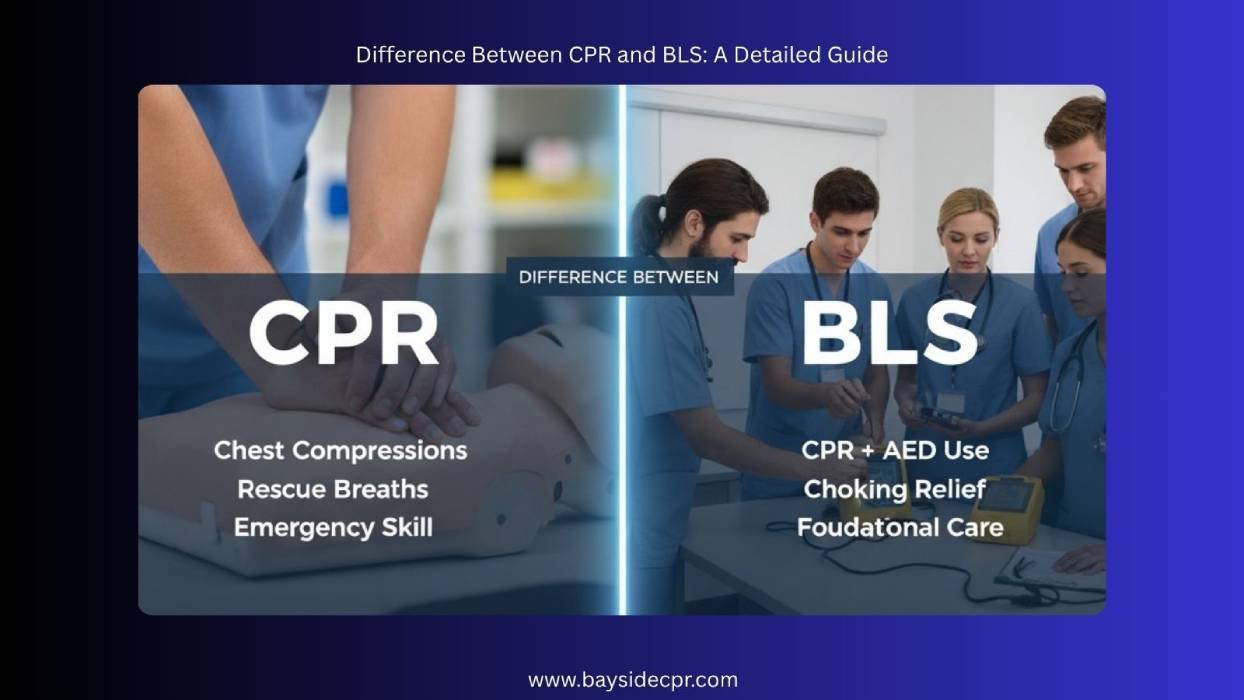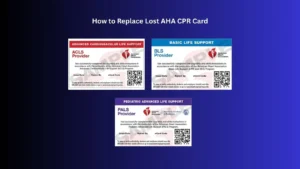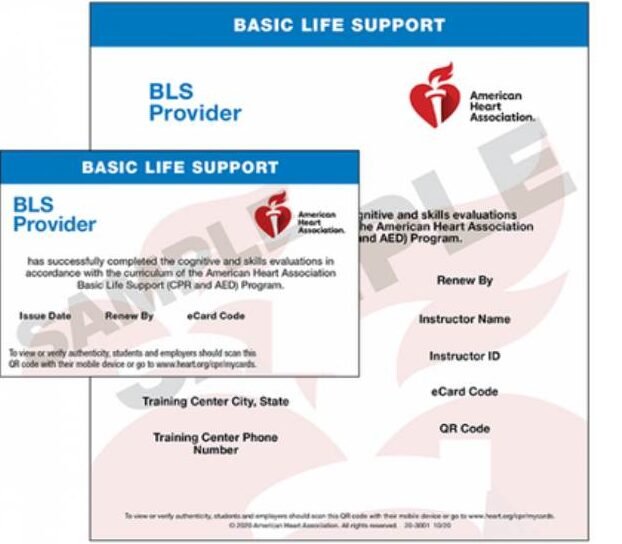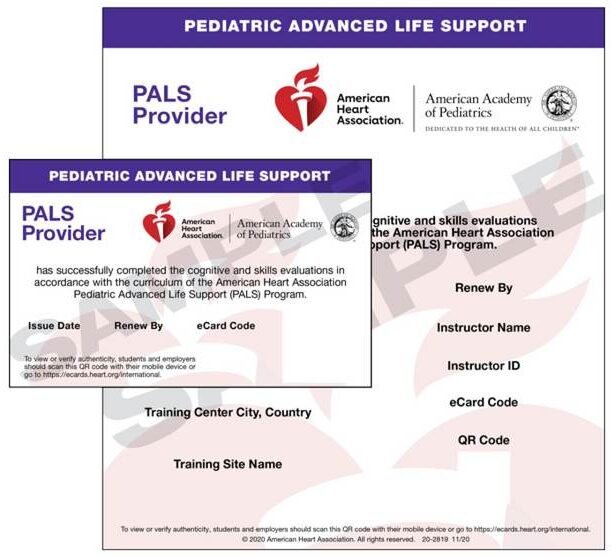When someone suddenly collapses, stops breathing, or their heart stops beating, the first few minutes are critical, and knowing how to respond can save a life. In these situations, two common terms arise: CPR (cardiopulmonary resuscitation) and BLS (basic life support). Although related, they are not the same. CPR is a basic life-saving skill that anyone can learn and perform, while BLS is a more advanced level of care typically required for healthcare professionals. Most healthcare employers require BLS certification, and many other industries encourage CPR training for lay rescuers. Both courses are available in-person or through blended (online and in-person) options.
What is CPR?
CPR is a life-saving technique used when someone’s heart has stopped beating or they’re no longer breathing properly. To understand the full range of methods, situations, and training options, you can visit our complete guide to CPR page. The purpose of CPR is to keep oxygenated blood flowing to the brain and vital organs until medical help arrives.
Key Features of CPR
- Chest Compressions: Pushing down on the chest to help the heart pump blood.
- Rescue Breaths: Giving air through the mouth to keep the lungs working (optional in hands-only CPR).
- AED Use (if available): An Automated External Defibrillator can restart the heart with an electric shock
Who Should Learn CPR?
Anyone can benefit from learning CPR because emergencies can happen anywhere and at any time. Parents and caregivers can keep their children safe, while teachers and school staff can respond quickly if a student gets hurt. People who work in offices, stores, or public places can help strangers in sudden medical situations. Even friends and neighbors can make a big difference by knowing how to act in critical moments. Learning CPR gives you the skills and confidence to save a life, and it is useful for everyone, not just medical professionals.
What is BLS?
Basic Life Support (BLS) is a more advanced form of CPR/AED primarily reserved for healthcare and public safety professionals. It includes all the core elements of CPR but goes further by incorporating additional skills and steps used in hospital and pre-hospital settings. BLS is designed for healthcare providers and emergency responders who need to perform life-saving interventions at a higher level of care.
What BLS Covers
BLS covers the essential steps to keep someone alive until advanced help arrives. It teaches how to recognize emergencies, give CPR, and use an AED with confidence.
- CPR Techniques: BLS teaches you how to perform chest compressions and rescue breaths the right way. These skills help keep oxygen flowing through the body until medical help takes over.
- Using an AED: You’ll learn how to use an automated external defibrillator to restart a heart that has stopped beating. It’s a simple device that can make a huge difference in saving someone’s life.
- Recognizing Cardiac Arrest: BLS helps you spot the early signs of cardiac arrest so you can act fast. Knowing what to look for gives you the confidence to start CPR right away.
- Helping Someone Who Is Choking: You’ll practice what to do when a person’s airway is blocked by food or an object. Quick action and the right technique can clear the airway and prevent serious harm.
- Working as a Team in Emergencies: BLS training shows how teamwork improves the chances of saving a life. Clear communication and coordination help everyone stay focused and respond effectively.
Who Needs BLS?
BLS training isn’t just for hospital staff; it’s for anyone who might need to save a life in an emergency. From nurses to firefighters, it gives people the skills to act fast and confidently when seconds count.
- Nurses are often the first to respond when a patient’s heart or breathing stops. BLS training helps them stay calm, act quickly, and give lifesaving care right away.
- Doctors need BLS skills to handle emergencies in any setting, whether it’s a hospital room or a clinic. It helps them respond fast and guide their team with confidence.
- Paramedics face life-and-death situations every day. BLS training gives them the solid foundation they need to perform high-quality CPR and save lives before reaching the hospital.
- Medical emergencies can happen even during a routine dental visit. BLS training helps dentists recognize and manage breathing or cardiac problems until help arrives.
- Lifeguards are trained to protect people around water, but emergencies can happen in seconds. With BLS skills, they can provide immediate care and increase a victim’s chance of survival.
- Police officers often reach the scene before medical help does. Knowing BLS allows them to start lifesaving care right away and make a real difference in critical moments.
- Firefighters do more than fight fires; they respond to many medical emergencies, too. BLS training equips them to perform CPR, use an AED, and stabilize victims until paramedics arrive.
- Medical students begin building their emergency care skills early in training. Learning BLS prepares them to act with confidence and provide effective help when it’s most needed.
In short, anyone working in the health or emergency care fields is expected to have a valid BLS certification.
CPR vs. BLS: What’s the Difference?
Although CPR is a part of BLS, they serve different purposes and audiences. Let’s compare them in detail.
| Aspect | CPR | BLS |
|---|---|---|
| Full Form | Cardiopulmonary Resuscitation | Basic Life Support |
| Audience | General public | Healthcare professionals |
| What You’ll Learn | Chest compressions, rescue breaths, AED | CPR plus advanced airway, team response, infant care |
| Certification Use | Personal use, workplace safety | Required in clinical and emergency settings |
| Equipment Training | AED (basic use) | AED, bag valve masks, suction devices |
Key Difference:
Why Learning Either (or Both) is Crucial
Learning CPR or both CPR and BLS can help you save lives in emergencies. Knowing these skills gives you the confidence to act quickly when someone needs help.
1. Faster Response Saves Lives
When you know CPR or BLS, you can step in immediately instead of waiting for help to arrive. Acting quickly can keep someone’s heart beating and lungs working until medical professionals take over. Being able to respond right away can make the difference between life and death, giving the person the best chance to survive.
2. Empowers You to Act
Learning CPR or BLS gives you the confidence to handle scary situations. You won’t feel frozen or unsure when someone collapses or struggles to breathe. Instead, you will know exactly what to do, which can calm both you and the person in need. This empowerment turns fear into action and lets you make a real difference in someone’s life.
3. Professional Requirement
For many jobs in healthcare, education, or public safety, knowing CPR or BLS is not just helpful; it is required. Employers want staff who can respond to emergencies and protect others. Having these skills can open doors in your career while also showing that you care about safety and being prepared. Being certified demonstrates responsibility and makes you a valuable member of any team, especially in careers that require CPR and first aid certification.
CPR and BLS Certification Requirements
Getting certified in CPR and BLS is simple and rewarding. Both AHA (American Heart Association) and ARC (American Red Cross) courses include hands-on practice and a short written test to make sure you understand the steps to respond during an emergency. You’ll learn how to recognize cardiac arrest, perform chest compressions, give rescue breaths, and use an AED safely. Healthcare providers, lifeguards, fitness trainers, and childcare workers often need certification for their jobs, but anyone can take the course. Once you pass, you’ll receive a certification card that’s usually valid for two years, showing you’re ready to help.
CPR and BLS: Your Lifesaving Skills
While CPR and BLS both teach you how to save a life, they are not the same. CPR is a great starting point for everyday people, offering basic but powerful life-saving skills. BLS builds on that foundation, offering more detailed instruction for professionals in the medical field. If you’re unsure where to begin, start with CPR, it’s quick, practical, and gives you the confidence to take action. If your role demands more, go for BLS and gain the skills to lead in high-stakes medical emergencies. No matter which you choose, learning how to respond in an emergency is a decision that can make a real difference, maybe even save someone’s life.
